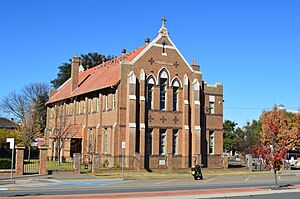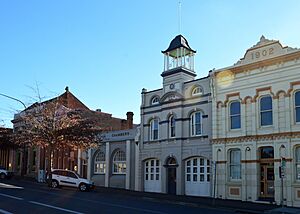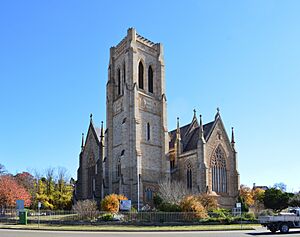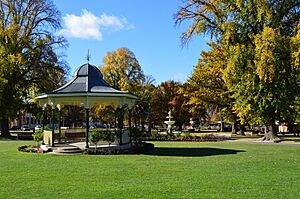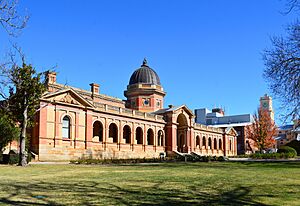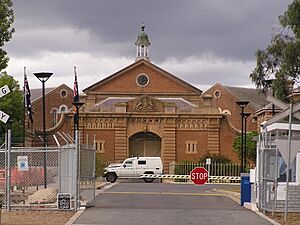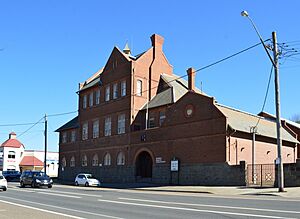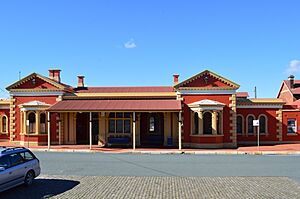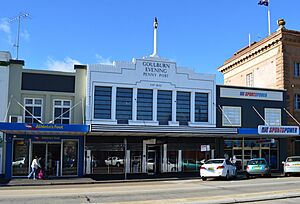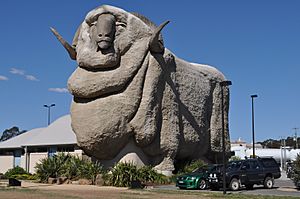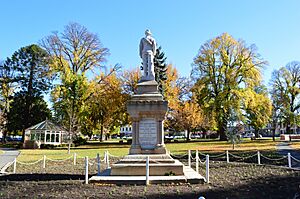Goulburn facts for kids
Quick facts for kids GoulburnNew South Wales |
|||||||||||||||
|---|---|---|---|---|---|---|---|---|---|---|---|---|---|---|---|

Goulburn city centre
|
|||||||||||||||
| Established | 1833 | ||||||||||||||
| Postcode(s) | 2580 | ||||||||||||||
| Elevation | 642 m (2,106 ft) | ||||||||||||||
| Location | |||||||||||||||
| LGA(s) | Goulburn Mulwaree Council | ||||||||||||||
| County | Argyle | ||||||||||||||
| Parish | Goulburn | ||||||||||||||
| State electorate(s) | Goulburn | ||||||||||||||
| Federal Division(s) | Hume | ||||||||||||||
|
|||||||||||||||
|
|||||||||||||||
Goulburn is a city in the Southern Tablelands of New South Wales, Australia. It is about 195 kilometers (121 miles) southwest of Sydney. It is also about 90 kilometers (56 miles) northeast of Canberra.
Goulburn was named Australia's first inland city in 1863 by Queen Victoria. In 2021, Goulburn had a population of 24,565 people. It is the main town for the Goulburn Mulwaree Council area.
Goulburn is a major railway hub on the Main Southern line. It is also a center for health and government services. The city supports the local farming industry. It is a popular stop for travelers on the Hume Highway. Goulburn has a historic park and many old buildings. It is also home to the Big Merino, a giant concrete sheep statue.
Contents
History of Goulburn
Goulburn was named by surveyor James Meehan. He named it after Henry Goulburn, who was a government official. Governor Lachlan Macquarie approved the name.
The government started giving land to settlers in the Goulburn area around 1820. This meant that the local Mulwaree Aboriginal population had to move. New animals brought by settlers also reduced the food available for Aboriginal people.
Indigenous History of the Mulwaree People
The Mulwaree People lived in the area that includes Goulburn, Crookwell, and Yass. They were part of the Ngunawal language group. To the north, the Gundungurra language was spoken. This was due to Gundungurra people moving south from their lands.
Their neighbors included the Dharawal people to the north. The Dharug people lived around Sydney. Other nearby groups were the Darkinung, Wiradjuri, Ngunawal, and Thurrawal peoples.
European Settlement in Goulburn
The first recorded settler in Goulburn started a farm called 'Strathallan' in 1825. A town was first planned in 1828. However, it was moved to its current spot in 1833 because of flooding. Surveyor Robert Hoddle designed the new town.
George Johnson bought the first land here between 1839 and 1842. He helped the town grow. He opened a store with a liquor license in 1848. In 1841, Goulburn had 665 people. By 1847, this number grew to 1,171. The town had a courthouse, police station, churches, a hospital, and a post office. It was a center for sheep farming.
A telegraph station opened in 1862. By then, Goulburn had about 1,500 residents. It also had a blacksmith, two hotels, and two stores. The town was a stop for Cobb & Co coaches by 1855. A police station opened in 1856 and a school in 1858. Goulburn became a local government area in 1859 and was made a city in 1863.
The railway arrived in 1869, which helped the city a lot. The line from Sydney to Albury was finished in 1883. Later, smaller railway lines were built to places like Cooma and Crookwell. Goulburn became a major railway center. It had a roundhouse for engines and a factory for railway parts. The roundhouse is now the Goulburn Rail Heritage Centre. Here you can see old steam and diesel trains.
St Saviour's Cathedral was finished in 1884. Its tower was added in 1988. It is the main church for the Anglican Bishop of Canberra and Goulburn. The Church of SS Peter and Paul was once the main church for the Roman Catholic Archdiocese of Canberra and Goulburn.
The Goulburn Viaduct was built in 1915. This brick railway bridge crosses the Mulwaree Ponds. It is the longest on the Main Southern railway line. It has 13 arches.
Goulburn Proclaimed a City Twice
Goulburn was officially declared a city two times. The first time was on March 14, 1863. This was done by Queen Victoria to create the Diocese of Goulburn for the Church of England. This was mainly for church reasons.
However, the official civil proclamation happened later. Goulburn was officially declared a city on March 20, 1885. This removed any doubts about its status. Goulburn then grew into an important regional center. It built an impressive court house in 1887 and other public buildings. It became a hub for selling wool and for industry.
Goulburn School Strike of 1962
In 1962, Goulburn was central to a big debate about government funding for private schools. A strike happened because a local Catholic primary school, St Brigid's, needed three more toilets. The Catholic church said they did not have enough money to build them.
So, the local Catholic schools closed. Nearly 1,000 Catholic children went to the government schools. The government schools could not fit all of them. The strike lasted only one week. But it caused a national discussion. In 1963, Prime Minister Robert Menzies promised government help for science buildings in private schools.
Heritage Listings in Goulburn
Goulburn has many places listed for their historical importance. These include:
- 165 Auburn Street: Goulburn Post Office
- 170 Bourke Street: St Saviour's Cathedral, Goulburn
- 197 Braidwood Road: Railway Barracks
- Bungonia Road: Old Goulburn Brewery
- Bungonia Road: Lansdowne Park
- Clifford Street: Colonial Mutual Life Building
- 248 Main Road: Rossi Bridge over Wollondilly River
- Main Southern railway: Goulburn Viaduct
- Main Southern railway: Goulburn railway station
- off Maud Street: Goulburn Correctional Centre
- Maud Street: Riversdale
- 4 Montague Street: Goulburn Court House
- Sloane Street: Connollys Mill
- Sloane Street: Old Police Barracks, Goulburn
- Sloane Street: Goulburn Railway Workshops
- 244–248 Sloane Street: Alpine Lodge Motel
- 318 Sloane Street: St Clair
- Taralga Road: Kenmore Asylum
- 42 Verner Street: St Peter and Paul's Old Cathedral
- Wollondilly River: Goulburn Pumping Station
Goulburn's Population and People
Based on the 2021 census, Goulburn had 24,565 people.
- Aboriginal and Torres Strait Islander people made up 5.3% of the population.
- 83.3% of people were born in Australia. Other common birthplaces included England (1.9%) and New Zealand (1.0%).
- 85.6% of people spoke only English at home. Other languages included Nepali (0.7%) and Mandarin (0.6%).
- For religion, 30.6% had No Religion. 25.3% were Catholic, and 20.8% were Anglican.
| Historical population | ||
|---|---|---|
| Year | Pop. | ±% |
| 1921 | 12,715 | — |
| 1933 | 14,849 | +16.8% |
| 1947 | 15,991 | +7.7% |
| 1954 | 19,183 | +20.0% |
| 1961 | 20,544 | +7.1% |
| 1966 | 20,871 | +1.6% |
| 1971 | 21,606 | +3.5% |
| 1976 | 21,735 | +0.6% |
| 1981 | 21,755 | +0.1% |
| 1986 | 21,552 | −0.9% |
| 1991 | 21,451 | −0.5% |
| 1996 | 21,293 | −0.7% |
| 2001 | 20,846 | −2.1% |
| 2006 | 20,127 | −3.4% |
| 2011 | 21,484 | +6.7% |
| 2016 | 22,419 | +4.4% |
| 2021 | 23,963 | +6.9% |
| Source: Australian Bureau of Statistics data. | ||
Geography of Goulburn
Goulburn is located just east of the Great Dividing Range. It is about 690 meters (2,260 feet) above sea level. The city has two rivers, the Wollondilly River and the Mulwaree River. They join together in Goulburn.
The Wollondilly River then flows northeast into Lake Burragorang. This lake is part of the Warragamba Dam. Eventually, the water reaches the Tasman Sea through the Hawkesbury River. The city is in an area known for its grasslands.
Goulburn's Climate
Goulburn has an oceanic climate. This means it has warm summers and cool winters. Temperatures change a lot between day and night. Summer temperatures can reach 28.3°C (82.9°F) in January. Winter temperatures can be around 11.8°C (53.2°F) in July.
Rainfall is spread out evenly through the year. The average yearly rainfall is 542.8 mm (21.4 inches). Snow sometimes falls, but usually not much. The lowest temperature recorded was -10.9°C (12.4°F). The highest was 42.8°C (109.0°F).
| Climate data for Goulburn Airport AWS (1991–2022); 640 m AMSL; 34.81° S, 149.73° E | |||||||||||||
|---|---|---|---|---|---|---|---|---|---|---|---|---|---|
| Month | Jan | Feb | Mar | Apr | May | Jun | Jul | Aug | Sep | Oct | Nov | Dec | Year |
| Record high °C (°F) | 42.8 (109.0) |
40.7 (105.3) |
35.9 (96.6) |
30.7 (87.3) |
24.4 (75.9) |
20.7 (69.3) |
19.7 (67.5) |
24.1 (75.4) |
30.5 (86.9) |
31.3 (88.3) |
39.9 (103.8) |
42.1 (107.8) |
42.8 (109.0) |
| Mean daily maximum °C (°F) | 28.1 (82.6) |
26.4 (79.5) |
23.7 (74.7) |
20.0 (68.0) |
15.9 (60.6) |
12.4 (54.3) |
11.8 (53.2) |
13.4 (56.1) |
16.6 (61.9) |
19.9 (67.8) |
23.0 (73.4) |
25.9 (78.6) |
19.8 (67.6) |
| Mean daily minimum °C (°F) | 12.9 (55.2) |
12.6 (54.7) |
10.2 (50.4) |
5.8 (42.4) |
2.5 (36.5) |
1.3 (34.3) |
0.3 (32.5) |
0.6 (33.1) |
3.0 (37.4) |
5.3 (41.5) |
8.3 (46.9) |
10.7 (51.3) |
6.1 (43.0) |
| Record low °C (°F) | −0.1 (31.8) |
0.7 (33.3) |
−0.1 (31.8) |
−6.3 (20.7) |
−8.1 (17.4) |
−10.2 (13.6) |
−10.4 (13.3) |
−10.9 (12.4) |
−7.4 (18.7) |
−5.6 (21.9) |
−4.4 (24.1) |
−1.2 (29.8) |
−10.9 (12.4) |
| Average precipitation mm (inches) | 54.8 (2.16) |
54.9 (2.16) |
49.3 (1.94) |
26.8 (1.06) |
34.6 (1.36) |
56.4 (2.22) |
32.6 (1.28) |
44.3 (1.74) |
44.9 (1.77) |
52.4 (2.06) |
61.3 (2.41) |
56.4 (2.22) |
575.2 (22.65) |
| Average precipitation days (≥ 0.2mm) | 8.3 | 9.1 | 10.5 | 9.1 | 11.9 | 14.7 | 13.9 | 12.0 | 11.3 | 10.0 | 10.0 | 8.4 | 129.2 |
| Average afternoon relative humidity (%) | 41 | 45 | 46 | 46 | 54 | 63 | 61 | 52 | 50 | 46 | 45 | 39 | 49 |
| Source: Australian Bureau of Meteorology; Goulburn Airport AWS | |||||||||||||
Governance in Goulburn
Goulburn is an important center in southern New South Wales. It has many key government buildings. The first lock-up (jail) was built in 1830. A postal service started in 1832.
The first town plan was made in 1828. But the site was moved because of floods. A new plan was drawn up in 1833. Goulburn is now the main town for the Goulburn Mulwaree Shire local government area. This council was formed in 2004.
New South Wales Police Academy
The Police Academy moved to Goulburn from Sydney in 1984. It is now called the New South Wales Police Academy. It is the largest training center for police officers in the southern hemisphere.
The Academy is located on the Wollondilly River. It has grown a lot since it moved. There is a new site on the Taralga Road. This site houses the New South Wales Police School of Traffic and Mobile Policing.
Goulburn Correctional Centre
Goulburn is home to the Goulburn Correctional Centre. This is a high-security prison for men. It is one of the highest-security prisons in Australia.
Culture and Sport in Goulburn
Theatre in Goulburn
Goulburn has Australia's oldest theatre company, the Lieder Theatre Company. It started in 1891. The company puts on many shows each year. They also have community events and workshops. The company is based in the historic Lieder Theatre, built in 1929.
A former quarry near Goulburn was used to film scenes for the 2016 movie Hacksaw Ridge.
Sports in Goulburn
The most popular sport in Goulburn is rugby league. The local team is the Goulburn City Bulldogs. They play in the Canberra Rugby League. The club started in 2020. Before that, there were other clubs like the Goulburn Workers Bulldogs.
The Goulburn Dirty Reds rugby union team plays in the John I Dent Cup. The Goulburn City Swans Australian rules club plays in a Canberra competition. Other sports played in Goulburn include soccer, cricket, and tennis.
Goulburn's Water Supply
Goulburn used to have problems with water shortages. So, an 84-kilometer (52-mile) underground water pipeline was built. It pumps water from the Wingecarribee Reservoir to Goulburn. This pipeline opened in 2011.
The pipeline can supply 7.5 million liters (2 million US gallons) of water per day. This $54 million project was the biggest construction project in Goulburn's history at the time.
Transport in Goulburn
Goulburn is about a two-hour drive from Sydney via the Hume Highway. It is about a one-hour drive from Canberra. In 1992, the Hume Highway was rerouted around Goulburn. This helped the city center become nicer. It also removed 23,000 cars from the city each day.
Goulburn railway station is the end point for the Southern Highlands Line. This line connects to Sydney. Most trains from Goulburn go to Moss Vale. There are also daily direct trains to Sydney Central. These services are run by NSW TrainLink.
Goulburn also has eight return bus services to Canberra each week. These buses connect to Canberra Airport, the city, and hospitals.
Goulburn Airport is about 7 kilometers (4 miles) south of Goulburn. It is used by small aircraft. Public transport in Goulburn includes local taxis and a bus service run by PBC Goulburn.
Media in Goulburn
Newspapers in Goulburn
The Goulburn Post is the local newspaper. It started as the Goulburn Evening Post in 1870. It is published three times a week.
Radio Stations in Goulburn
You can listen to many radio stations in Goulburn:
- Radio National (2RN) 1098 AM
- Triple J (2JJJ) 88.7 FM
- ABC Classic FM (2ABCFM) 89.5 FM
- ABC Riverina (2ABCRR) 90.3 FM
- Eagle FM 93.5 (2SNO)
- Sky Sports Radio 94.3 FM
- ABC NewsRadio (2PNN) 99.9 FM
- Kix Country Radio 100.7 FM
- 2GCR 103.3 FM
- GNFM 107.7 FM (2GBN)
Television in Goulburn
Goulburn gets five free TV channels. These are sent from Canberra and broadcast from Mt Gray:
Landmarks in Goulburn
Goulburn's second court house was built in 1847. It was designed by Mortimer Lewis. James Barnet, a colonial architect, designed many buildings in Goulburn. These include the Goulburn Gaol (opened 1884) and the current court house (opened 1887). He also designed the post office in 1881.
Walter Liberty Vernon designed the first buildings of Kenmore Hospital, completed in 1894. St Saviour's Anglican Cathedral was designed by Edmund Blacket. Building started in 1874 and it was dedicated in 1884. A tower was added in 1988.
E.C. Manfred was a famous local architect. He designed many city buildings. These include the first public swimming baths (1892), the old Town Hall (1888), and the Goulburn Base Hospital (1886). He also designed the old Fire Station (1890) and the Masonic Temple (1928). Kenmore Hospital, a psychiatric hospital, closed in 2003. Mental health services are now at the Goulburn Base Hospital.
Goulburn Rail Heritage Centre
The roundhouse in Goulburn was a very important place for trains. It stored and serviced steam and early diesel locomotives. After it closed, it became the Goulburn Rail Heritage Centre. This is a railway museum. It has old steam and diesel trains. You can also see many interesting railway cars. The Railway Barracks were built in 1935. They housed train drivers. Now, they are used for accommodation and events.
Notable People from Goulburn
- Andrew Blackshaw, international softball player
- Beatrice Bligh (1916–1973), gardener
- Todd Carney, (born 1986) rugby league player
- Kyle Cranston, (born 1993) track and field athlete
- Jarrod Croker, (born 1990) rugby league player, captain Canberra Raiders
- Bruce Devlin, former professional golfer
- Michael Diamond, Olympic gold medalist in shooting
- Miles Franklin, (1879–1954) writer and feminist
- Thomas Hazelton, (born 1999) rugby league footballer
- William Hovell, (1786–1875) explorer, buried in Goulburn
- Rod Jackson, (born 1951) rugby league player
- George Lazenby, (born 1939) Australian actor who played James Bond
- Donald MacDonald, (1857–1937) Australian pastoralist
- Marc McDermott, (1871–1929) American silent film star
- Adam O'Brien, (born 1977) rugby league coach
- George Ogilvie, theatre director
- Simon Poidevin, rugby union player and World Cup winner
- Kate Ritchie, (born 1978) actress and radio host
- Sally Shaw, (born 1978) cricketer
- Ursula Stephens, senator (2002–2014)
- Glenn Turner, Kookaburras hockey player
- Peta Murphy (1973–2023), federal MP
See also
 In Spanish: Goulburn para niños
In Spanish: Goulburn para niños





